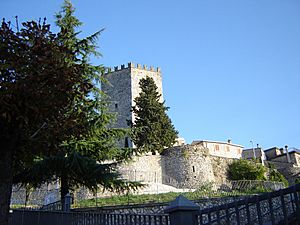Thomas Aquinas facts for kids
Quick facts for kids SaintThomas Aquinas OP |
|
|---|---|
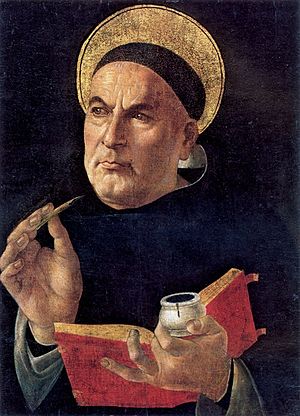
Thomas Aquinas by Sandro Botticelli
|
|
| Confessor Doctor of the Church |
|
| Born | Tommaso d'Aquino 1225 Roccasecca, Kingdom of Sicily |
| Died | 7 March 1274 (aged 48–49) Fossanova, Papal States |
| Venerated in | Roman Catholic Church Anglican Communion Lutheranism |
| Canonized | 18 July 1323, Avignon, Papal States by Pope John XXII |
| Major shrine | Church of the Jacobins, Toulouse, France |
| Feast | 28 January, 7 March (pre-1969 Roman Calendar) |
| Attributes | The Summa Theologiae, a model church, the sun on the chest of a Dominican friar |
| Patronage | Academics; against storms; against lightning; apologists; Aquino, Italy; Belcastro, Italy; book sellers; Catholic academies, schools, and universities; chastity; Falena, Italy; learning; pencil makers; philosophers; publishers; scholars; students; University of Santo Tomas; Sto. Tomas, Batangas; Mangaldan, Pangasinan; theologians |
Thomas Aquinas (born Tommaso d'Aquino; 1225 – March 7, 1274) was an Italian Dominican friar and priest. He was a very important philosopher and theologian. People called him the Doctor Angelicus (the Angelic Doctor), the Doctor Communis (the Common Doctor), and the Doctor Universalis (the Universal Doctor). In 1999, he was also called the Doctor Humanitatis (the Doctor of Humanity).
The Catholic Church sees Thomas Aquinas as a saint. He is considered a perfect example for students who are studying to become priests.
Contents
Thomas Aquinas: His Early Life (1225–1244)
Thomas Aquinas was probably born around 1225 in a castle called Roccasecca. This castle was near a town named Aquino.
His family was very powerful and wealthy. While his brothers chose to be soldiers, Thomas's family wanted him to become an abbot, like his uncle. This was a common path for younger sons of noble families in southern Italy.
When he was five, Thomas started school at Monte Cassino. Later, he went to the University of Naples. There, he learned about math, shapes, stars, and music. At this university, Thomas first read books by Aristotle, Averroes, and Maimonides. Their ideas would later shape his own thinking about religion and philosophy.
At 19, Thomas decided to join the Dominican Order. His family was very upset and tried to stop him.
Thomas was kept prisoner for almost a year in his family's castles at Monte San Giovanni and Roccasecca. During this time, Thomas taught his sisters and talked with members of the Dominican Order.
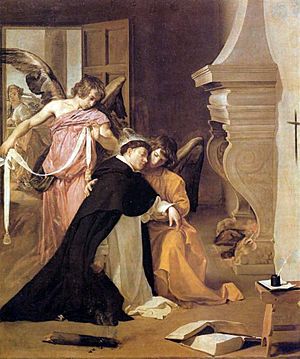
Thomas was determined to join the Dominicans. By 1244, his mother, Theodora, saw that she could not change his mind. She helped him escape at night through a window. She thought a secret escape was better than openly giving in to the Dominicans. Thomas was sent to Naples and then to Rome to meet Johannes von Wildeshausen, who was the leader of the Dominican Order.
Thomas Aquinas: His Career and Teachings
In 1245, Thomas went to study at the University of Paris. There, he likely met another Dominican scholar, Albertus Magnus. When Albertus moved to teach in Cologne in 1248, Thomas went with him. He even turned down an offer from Pope Innocent IV to become an abbot.
Thomas taught in Cologne as a student teacher. In 1252, he returned to Paris to get a master's degree in theology. He lectured on the Bible and spent three years studying and writing comments on Peter Lombard's Sentences.
In 1256, Thomas became a master in theology at Paris. From 1256 to 1259, Thomas wrote many important works. By the end of this time, he was working on one of his most famous books, Summa contra Gentiles.
In 1259, Thomas finished his first teaching period in Paris. He left so that other Dominicans could also get teaching experience. He went back to Naples and became a general preacher in 1260.
In 1261, he was called to Orvieto. There, Thomas finished his Summa contra Gentiles. He also wrote Catena aurea (The Golden Chain) and other works for Pope Urban IV. Some of the songs Thomas wrote for the feast of Corpus Christi are still sung today. These include Pange lingua and Panis angelicus.
In 1265, the new Pope Clement IV asked Thomas to come to Rome to be a papal theologian. In the same year, he was told by the Dominican leaders to teach at the convent of Santa Sabina in Rome.
While at Santa Sabina, Thomas started his most famous work, the Summa Theologiae. He also wrote many other books. As the head of the school, Thomas led important discussions about God's power. He put these discussions into his book De potentia.
Thomas stayed at Santa Sabina until 1268. Then, he was called back to Paris for a second time to teach. He stayed there until 1272.
In 1272, Thomas left the University of Paris. The Dominicans from his home area asked him to start a new school wherever he wanted. He chose Naples and moved there to be the main teacher. In Naples, he worked on the third part of the Summa. He also gave talks on different religious topics. He preached to the people of Naples every day during Lent in 1273. His sermons on the Commandments, the Creed, and prayers were very popular.
Thomas Aquinas: His Death
In 1054, the Great Schism happened. This was a big split between the Catholic Church in the West and the Eastern Orthodox Church. Pope Gregory X wanted to bring them back together. He called a meeting, the Second Council of Lyon, for May 1, 1274. Thomas was asked to attend. At the meeting, Thomas's work for Pope Urban IV, called Contra errores graecorum, was going to be shared.
On his way to the meeting, riding a donkey, he hit his head on a fallen tree branch and became very sick. He was taken to Monte Cassino. After resting, he tried to travel again but fell ill at the Cistercian Fossanova Abbey. The monks took care of him for several days. As he received his last rites, he prayed: "I have written and taught much about this very holy Body, and about the other sacraments in the faith of Christ, and about the Holy Roman Church, to whose correction I expose and submit everything I have written."
He died on March 7, 1274, while he was talking about the Song of Songs.
Thomas Aquinas: Becoming a Saint
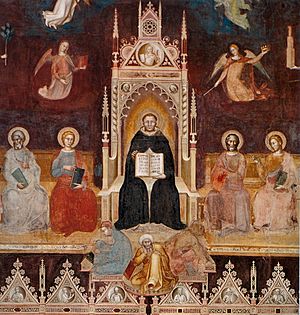
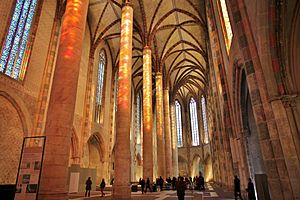
Fifty years after Thomas died, on July 18, 1323, Pope John XXII declared him a saint. This happened in Avignon.
A monastery in Naples, near Naples Cathedral, has a room where he supposedly lived. His remains were moved from Fossanova to the Church of the Jacobins in Toulouse on January 28, 1369. For a while, they were in the Basilica of Saint-Sernin. In 1974, they were returned to the Church of the Jacobins, where they are now.
When he became a saint, his feast day was set for March 7, the day he died. But because this date often falls during Lent, the calendar was changed in 1969. His memorial day is now January 28. This is the day his body was moved to the Church of the Jacobins in Toulouse.
Thomas Aquinas is also honored with a feast day in some churches of the Anglican Communion on January 28.
Thomas Aquinas: His Ideas
Thomas Aquinas was a strong supporter of natural theology. This means he believed that people can learn about God by using their minds and observing the world. He started a way of thinking called Thomism. He taught that God is the source of both natural understanding and religious faith.
Thomas thought that God's existence is clear in itself, but not always clear to us. He believed that we can prove God exists. He argued that faith and reason, science and religion, can all work together. Aquinas also wrote about many different ideas in philosophy. He believed that people's goal is to grow closer to God, not to try to escape Him. Aquinas thought that having a king or a group of nobles rule were fair ways to govern.
He has been called "the most important thinker of the medieval period" and "the greatest of the medieval philosopher-theologians." His ideas greatly influenced Western thought and modern philosophy. This is especially true in areas like what is right and wrong, natural law, the nature of reality, and how governments should work.
Thomas Aquinas: Famous Quotes
- "There is nothing on this earth more to be prized than true friendship."
- "Three things are necessary for the salvation of man: to know what he ought to believe; to know what he ought to desire; and to know what he ought to do."
- "Love takes up where knowledge leaves off."
- "The things that we love tell us what we are."
- "Friendship is the source of the greatest pleasures, and without friends even the most agreeable pursuits become tedious."
- "All the efforts of the human mind cannot exhaust the essence of a single fly."
- "Wonder is the desire for knowledge."
- "Distinctions drawn by the mind are not necessarily equivalent to distinctions in reality."
Thomas Aquinas: His Works
His most well-known books are:
- the Disputed Questions on Truth (1256–1259)
- the Summa contra Gentiles (1259–1265)
- and the unfinished Summa Theologica, or Summa Theologiae (1265–1274)
He also wrote comments on Scripture (holy texts) and on the writings of Aristotle.
Thomas Aquinas: Interesting Facts
- Thomas wrote hymns (religious songs) that are still used in church services today.
- Today, studying his works is a main part of the training for people who want to become priests or deacons. It's also important for students of other religious subjects like philosophy and church history.
- Because Thomas was quiet and didn't talk much, some of his classmates thought he was slow.
- People have traditionally said that Thomas could levitate, which means float in the air.
Images for kids
-
Triumph of St Thomas Aquinas, the Doctor Communis, between Plato and Aristotle, by Benozzo Gozzoli, 1471. Louvre, Paris.
-
Detail of The Apotheosis of Saint Thomas Aquinas by Francisco de Zurbarán, 1631
-
Thomas Aquinas by Bartolomé Esteban Murillo, 1650
-
Portrait of St. Thomas by Antonio del Castillo y Saavedra, around 1649
-
A stained glass window of Thomas Aquinas in St. Joseph's Catholic Church (Central City, Kentucky)
See also
 In Spanish: Tomás de Aquino para niños
In Spanish: Tomás de Aquino para niños


